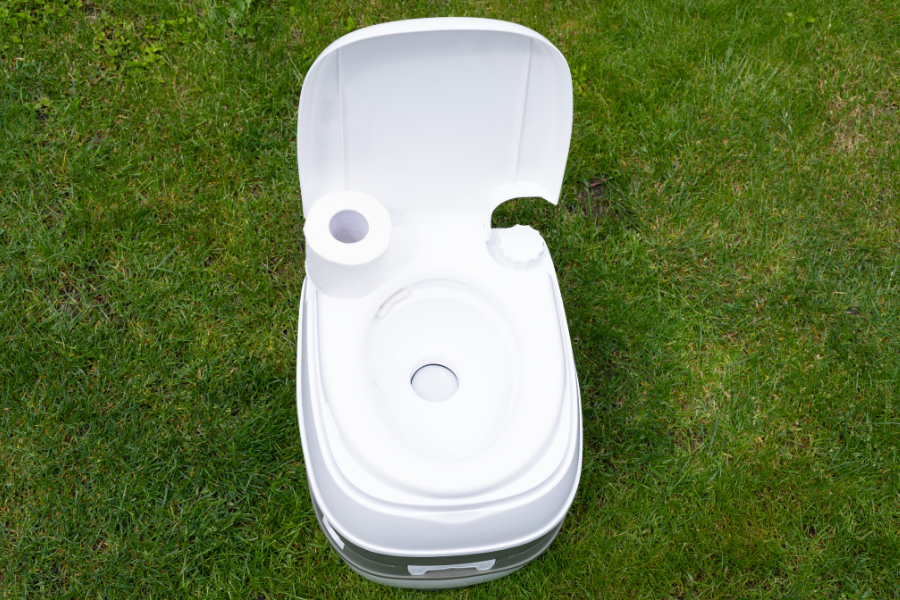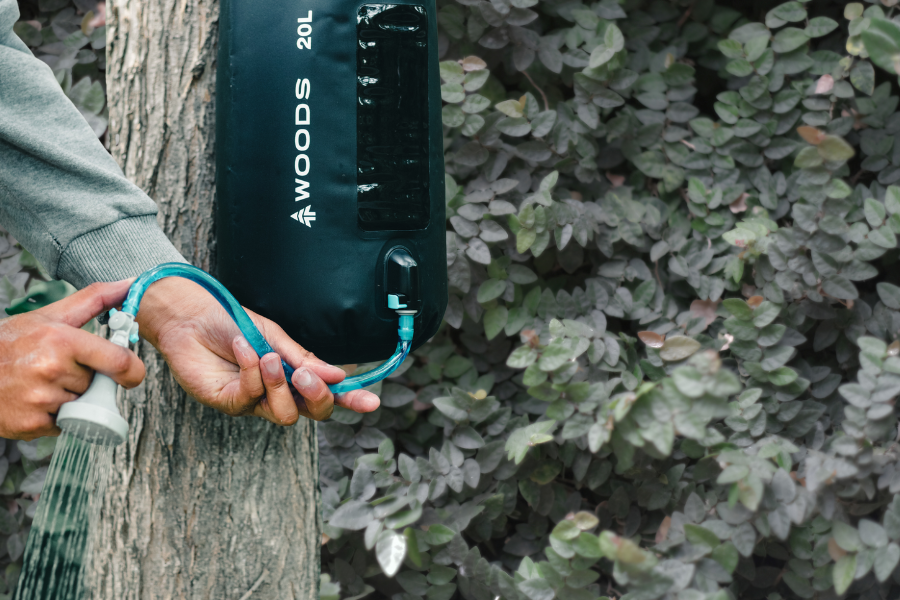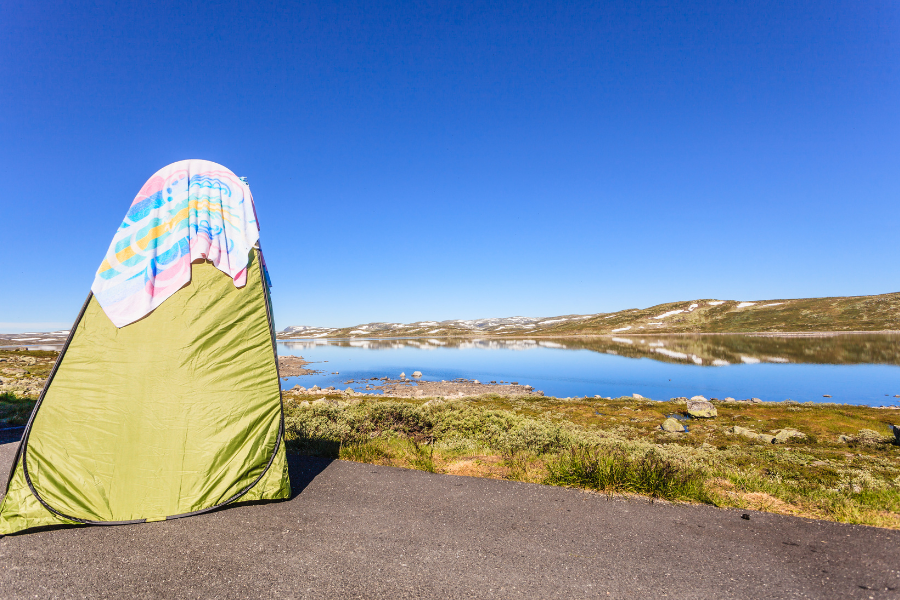Fun in the Wild: Mastering Clean Water, Showers, and Toilets While Camping!
Introduction
Hello fellow camping enthusiasts! Isn’t it incredible how immersing ourselves in the great outdoors can both reset our minds and challenge us in new ways? Well, one of those challenges often revolves around keeping ourselves clean and healthy with camping hygiene.
Campers valued amenities like toilets, shower facilities, and campfire rings, with a Kampgrounds of America (KOA) report in 2020 revealing that 34% of campers ranked having a restroom with plumbing as the most important amenity.
What about the rest of us 66%? We’re happy to work this out on our own. It’s absolutely possible to maintain a high standard of cleanliness even when we’re miles away from the nearest bathroom.
Why An Article on Camping Hygiene?
It goes without saying, that staying clean isn’t just about feeling fresh, it’s a critical factor in preventing illnesses and infections during your camping trip. When you’re miles away from the nearest medical help, a small cut or getting sick from water-borne illnesses can become a big deal. Let’s explore how.
General Tips for Camping Hygiene
1. Pack Essential Hygiene Supplies
Just as you wouldn’t forget your tent or sleeping bag, you should always pack a hygiene kit when camping. Beyond the normal items like toothpaste, toothbrush, biodegradable soap, hand sanitizer, and toilet paper, you should add sunscreen and a first aid kit for any unexpected mishaps.
2. Clean Water – avoiding Beaver Fever

Ever heard of “Beaver Fever”? No, it’s not the latest dance craze sweeping the nation. It’s actually a less-than-pleasant waterborne illness also known as Giardiasis, and it’s just one of the pesky invaders that can hitch a ride in your water bottle during your outdoor adventures.
Depending on how long you will be away, you can always buy your clean water. However, if you are boondocking or just enjoying yourself too much where you are, you may not want to leave to head back to civilization just to go buy more water when you run out.
If you have to use water that’s on-site, the battle against Beaver Fever and other waterborne micro-nasties is not lost. Always boil, filter, or purify natural water sources before consumption. With a bevy of high-tech, user-friendly, and swift-acting water purifying products flooding the market, you can gulp down your H2O without a worry in the world. Here are some options to consider:
a. Portable Water Filters
Portable water filters have seen significant improvements in recent years. Devices such as LifeStraw and Sawyer Mini filters are compact, lightweight, and capable of removing 99.9999% of bacteria and parasites. These straw-like devices allow you to drink directly from a water source and filter it in real-time for your clean water needs.
b. Pump Filters
Pump filters like the MSR MiniWorks EX are also a great choice. These filters pump water through a ceramic or carbon element to remove bacteria and parasites. Some models also remove chemicals and improve taste.
c. Ultraviolet (UV) Light Purifiers
UV purifiers like the SteriPEN are an innovative solution for water purification in a pinch though we find they are only handy for hikes. They use ultraviolet light to kill bacteria, viruses, and protozoa. It’s as simple as stirring the device in your water container for a couple of minutes.
d. Bottle Filters
Another quick option that’s perfect for hiking, bottle filters, such as those made by GRAYL, combine a water container and a filter into a single convenient device. Simply fill the bottle, press the filter down, and you have clean, drinkable water.
e. Water Purification Tablets
While not a new invention, water purification tablets remain a reliable and lightweight option for water treatment. They have been improved over time to work quickly and leave minimal aftertaste.
f. Gravity Filters
For larger groups, gravity filters like the Platypus GravityWorks system can be an efficient way to purify a significant amount of water at once. You fill a bag with dirty water, hang it, and let gravity pull the water through the filter into a clean reservoir.
While all of these options can provide clean water quickly, remember that the best method for you will depend on your specific camping situation. Consider the size of your group, the weight and size of the device, the speed of purification, and the type of pathogens it can remove when making your choice. With the right water purification method, you can ensure clean water and not getting sick.
3. When Nature Calls and There’s No Campground Toilet
Answering nature’s call while camping in the great outdoors can indeed present a unique challenge, especially when there isn’t a designated campground toilet in sight. Digging ‘cat holes’ isn’t really the answer as more and more of us head to the outdoors, burying our poop is becoming a problem. However, fret not! We have a couple of practical, hygienic, and environmentally friendly solutions that you can consider given you are car camping and not packing in or out of your site (backpacking) which you will have to use the WAG alternative.
Dry Portable Toilets and Freshwater Flush Tank Options

Portable toilets have made quite the evolution in the realm of camping hygiene. From dry to freshwater flush systems, campers have a variety of choices to ensure their needs are met. Let’s explore a couple of popular and diverse options.
Dry Portable Toilet
Dry portable toilets are an innovative solution that provides a high level of comfort and camping hygiene, while also being environmentally friendly. They operate differently from traditional portable toilets as they do not use a liquid chemical base. The main principle behind dry toilets is the separation of liquid and solid waste, which makes handling and disposal easier and more hygienic.
The BOXIO Portable Toilet is a more budget-friendly pick in the dry portable toilet category. Operating without the use of water or chemicals, it effectively separates liquid and solid waste into individual compartments. The benefit of this separation is two-fold: it not only substantially reduces odors, but also makes the waste easier to handle. In the solid waste compartment, a bulking material such as coconut coir or peat moss is used, promoting composting and minimizing smells even further.
Freshwater Flush Toilet
On the other hand, the Camco Portable Travel Toilet, available on Amazon, is what we use when we are not boondocking and are close to a public bathroom where we can dispose of the waste every couple of days. This is a fantastic option for those who prefer a freshwater flush system and comes with a 5.3-gallon detachable holding tank and a 2.5-gallon flush tank. The sealing slide valve on the Camco Portable Travel Toilet locks in odors and protects against leakage, which we are thankful for when we are driving our waste to where we can safely dispose of it. This model is a bit more similar to the toilet you’re used to at home, providing that extra bit of comfort in the great outdoors.
Whether you prefer the dry method or a freshwater flush system, both the BOXIO Portable Toilet and the Camco Portable Travel Toilet are environmentally friendly solutions that bring a new level of convenience to your camping experience. Always remember, regardless of the model you choose, responsible waste disposal is crucial in protecting and respecting our beautiful outdoors.
DIY Your Own Toilet
This might sound like an intimidating task, but with a little creativity, you can create your own makeshift toilet in the wilderness. Here’s how you can do it:
1. Get a 5-Gallon Bucket: These are readily available, incredibly sturdy, and provide ample space for waste. A bucket with a sealing lid can also help control the smell.
2. Buy a Toilet Seat: Visit your local hardware store and purchase a toilet seat. Some seats are designed specifically to fit on top of 5-gallon buckets, so try to opt for one of those.
3. Set Up Your Toilet: Attach the toilet seat to the top of the bucket, and you’ve got yourself a DIY portable toilet. For extra comfort, you can place a garbage bag inside the bucket before attaching the seat. This will make waste disposal much easier.
4. Disposal: If you use a bag, always pack out your waste. If you don’t use a bag, you can dig a “cathole” about 6-8 inches deep and at least 200 feet away from water sources, campsites, and trails. Empty your bucket there and cover the waste with soil when done.
Environmentally-Friendly Disposal
In all of the toilet solutions mentioned above, using an environmentally friendly waste breakdown chemical is highly recommended. These chemicals are designed to accelerate the decomposition process of human waste, making disposal more hygienic and environmentally safe.
Here’s how you can incorporate them into your camping hygiene routine:
- For portable toilets, there are specific products designed to break down waste and control odors. When using a portable toilet, you can add these chemicals directly to the waste tank. Follow the product instructions for the appropriate amount to use and how often to add them.
- When using a toilet tent paired with a portable toilet or a DIY bucket toilet, you can still use these chemicals effectively. If you’re using a garbage bag inside your toilet setup, add a small amount of waste breakdown chemical to the bag before use. This can greatly help in breaking down waste, reducing smell, and making the eventual disposal less unpleasant.
- When purchasing these chemicals, it’s important to ensure that they are indeed environmentally friendly and biodegradable. Look for products that are formaldehyde-free and non-staining. They should also be safe for all septic tanks. Some camping supply stores and many online retailers offer a variety of these products specifically designed for camping use.
Remember, maintaining camping hygiene isn’t just about your comfort. It’s also about preserving the natural beauty of the outdoor spaces we enjoy. By using environmentally friendly products and practicing responsible waste disposal, you’re helping ensure that these spaces can be enjoyed by generations to come. Always ensure that you leave no trace behind, even if it means carrying your waste until you find an appropriate disposal location.
4. It’s Shower Time! What to do when there’s no Shower Facility
Keeping clean during a camping trip can be a refreshing part of the experience, and it’s not as hard as you might think, even when you don’t have access to a shower. Here are a few ingenious methods that can keep you feeling fresh and clean, using items you might already have at your disposal or building your very own camping shower tent for the ultimate experience.
Wet Wipes and No-Rinse Soaps
The easiest and most weight-efficient way to clean up without a shower is by using biodegradable wet wipes and no-rinse soaps. They can help you freshen up after a long day of hiking and also come in handy when you need to wash your hands before eating or after visiting the ‘bathroom’. Just make sure to choose biodegradable options to minimize your impact on the environment.
Face Refresh with Micellar Water and Cotton Balls
When your skin is yearning for a quick refresh after a day of outdoor activities, micellar water can be a lifesaver. A popular example is Garnier Micellar Water, which I pick up from Target. It draws out dirt, oil, and makeup from your skin, just like a magnet, leaving it clean and hydrated.
The best part? There’s no need to rinse off afterwards, saving you precious water while camping. Plus, the bottle is compact enough to fit snugly into your camping bag without taking up much space.
DIY Shower
In case you have more water at your disposal and crave for a ‘real’ shower, a DIY bottle shower could be your best bet. All you need is a large plastic water bottle. Poke several small holes in the lid, fill it with water, and voila, you’ve got yourself a mini shower. Alternatively, you can buy an attachment on Amazon to convert your water or soda bottles into instant outdoor showers for you and your Dog. For a warm shower, leave the filled bottle in the sun for a few hours.
The best shower I ever had was a makeshift shower in the middle of the Himalayas that used a large plastic bucket and the water was warmed by the sun which had a small lever with a string to pour water over you in small measures. Magic!
Portable Camping Showers

For a more luxurious experience, consider investing in a portable camping shower. They come in a variety of styles. Some are solar-heated bags that warm up when left in the sun, and others are more advanced pressurized systems. Prop it up in your portable camping shower tent that you use for your toilet for instant privacy!
5. Portable Toilet and Shower Tents

But wait, what about privacy? Shower and toilet tents are lightweight, easy to set up and offer the much-needed privacy that the open woods can’t provide. It does double duty to pair them up with a portable toilet or a homemade one for a more comfortable experience and for taking that much-needed shower.
6. Handwashing Stations
Just as important as keeping your body clean is ensuring that your hands are clean, especially before handling food. One creative solution is to set up a handwashing station using a recycled plastic container with a spout. Fill it with water and place it at a height where the spout can be used as a faucet. Place a basin underneath to catch the runoff water. With biodegradable soap and hand sanitizer nearby or attached to the container, you have a readily available handwashing station. Don’t forget the paper towels or better yet, reusable water-wicking mini towels.
Final Thoughts
Camping offers an escape from our busy lives, a chance to immerse ourselves in nature, admire the starlit skies and enjoy the tranquil silence that’s hard to find in our day-to-day lives. However, the excitement of camping we need to plan in advance how we are going to take care of the ‘necessities’.
From creative bathing solutions like DIY bottle showers and portable camping showers to handwashing stations built from recycled plastic, staying clean on a camping trip is both manageable and innovative. Establishing your personal toilet system is also possible, be it portable toilets, toilet tents, or DIY toilets, enhancing comfort during your camping experience. Thanks to the advances in technology, we have a host of eco-friendly chemicals that help in breaking down waste, making disposal not just more hygienic but also environmentally safe.
Clean water, a crucial part of our camping hygiene routine, is now more accessible with the availability of various water purification devices. Whether you choose portable water filters, UV purifiers, bottle filters, or traditional purification tablets, you’re guaranteed to have safe drinking water at all times.
To sum it up, camping health and hygiene are attainable and comfortable with the right knowledge, tools, and respect for the environment. Every small step we take, like using biodegradable products or responsibly disposing of our waste, contributes to this goal.
After all, a clean camper isn’t just a happy camper but a responsible and respectful one, too.
FAQs
1. What’s the best way to dispose of waste when camping?
- The best way is to pack out your waste, using catholes is not recommended due to the large numbers of fellow campers in the wild.
2. How can I keep my hands clean while camping?
- Use biodegradable soap and water, or hand sanitizer when water is scarce.
3. What type of food is best for camping to maintain hygiene?
- Non-perishable foods are the best to prevent foodborne illnesses.
4. Can I use any water for cleaning dishes or bathing?
- All water should be boiled or purified before use to kill any harmful bacteria.
5. How often should I shower during a camping trip?
- It depends on your activity level, but using wet wipes for a quick clean-up can suffice for a couple of days.





Comments are closed.